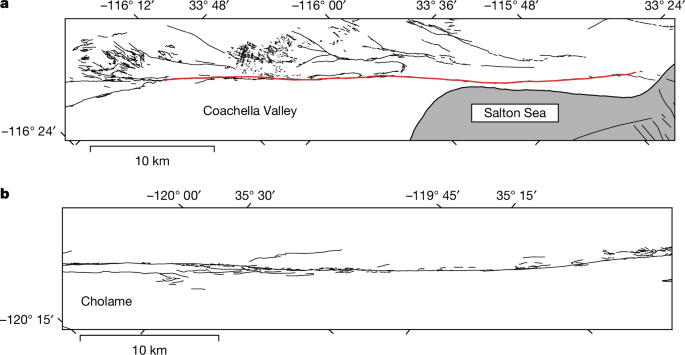Harris, R. A. Large earthquakes and creeping faults. Rev. Geophys. 55, 169–198 (2017).
Lee, J., Tsai, V. C., Hirth, G., Chatterjee, A. & Trugman, D. T. Fault-network geometry influences earthquake frictional behaviour. Nature 631, 106–110 (2024).
Bürgmann, R. The geophysics, geology and mechanics of slow fault slip. Earth Planet. Sci. Lett. 495, 112–134 (2018).
Dieterich, J. H. Modeling of rock friction: 1. Experimental results and constitutive equations. J. Geophys. Res. Solid Earth 84, 2161–2168 (1979).
Schulz, S. S., Mavko, G. M., Burford, R. O. & Stuart, W. D. Long-term fault creep observations in central California. J. Geophys. Res. Solid Earth 87, 6977–6982 (1982).
Kaneko, Y., Fialko, Y., Sandwell, D., Tong, X. & Furuya, M. Interseismic deformation and creep along the central section of the North Anatolian Fault (Turkey): InSAR observations and implications for rate-and-state friction properties. J. Geophys. Res. Solid Earth 118, 316–331 (2013).
Lindsey, E. O. & Fialko, Y. Geodetic constraints on frictional properties and earthquake hazard in the Imperial Valley, Southern California. J. Geophys. Res. Solid Earth 121, 1097–1113 (2016).
Savage, J. & Lisowski, M. Inferred depth of creep on the Hayward fault, central California. J. Geophys. Res. Solid Earth 98, 787–793 (1993).
Vavra, E. J. et al. Active dipping interface of the Southern San Andreas fault revealed by space geodetic and seismic imaging. J. Geophys. Res. Solid Earth 128, e2023JB026811 (2023).
Thatcher, W. & Hill, D. P. Fault orientations in extensional and conjugate strike-slip environments and their implications. Geology 19, 1116–1120 (1991).
Fialko, Y. Estimation of absolute stress in the hypocentral region of the 2019 Ridgecrest, California, earthquakes. J. Geophys. Res. Solid Earth 126, e2021JB022000 (2021).
Zou, X., Fialko, Y., Dennehy, A., Cloninger, A. & Semnani, S. J. High-angle active conjugate faults in the Anza-Borrego Shear Zone, Southern California. Geophys. Res. Lett. 50, e2023GL105783 (2023).
Provost, A.-S. & Houston, H. Orientation of the stress field surrounding the creeping section of the San Andreas Fault: evidence for a narrow mechanically weak fault zone. J. Geophys. Res. Solid Earth 106, 11373–11386 (2001).
Poliakov, A. B., Dmowska, R. & Rice, J. R. Dynamic shear rupture interactions with fault bends and off-axis secondary faulting. J. Geophys. Res. Solid Earth 107, 2295 (2002).
Moore, D. E. & Rymer, M. J. Talc-bearing serpentinite and the creeping section of the San Andreas fault. Nature 448, 795–797 (2007).
Vavra, E. J. et al. Characteristic slow-slip events on the Superstition Hills Fault, Southern California. Geophys. Res. Lett. 51, e2023GL107244 (2024).
Wang, K. & Fialko, Y. Space geodetic observations and models of postseismic deformation due to the 2005 M7.6 Kashmir (Pakistan) earthquake. J. Geophys. Res. Solid Earth 119, 7306–7318 (2014).
Wang, K. & Fialko, Y. Observations and modeling of coseismic and postseismic deformation due to the 2015 Mw 7.8 Gorkha (Nepal) earthquake. J. Geophys. Res. Solid Earth 123, 761–779 (2018).
Brown, K. M. & Fialko, Y. ‘Melt welt’ mechanism of extreme weakening of gabbro at seismic slip rates. Nature 488, 638–641 (2012).
Noda, H. & Lapusta, N. Stable creeping fault segments can become destructive as a result of dynamic weakening. Nature 493, 518–521 (2013).
Jennings, C. W. & Bryant, W. A. Fault Activity Map of California. California Division of Mines and Geology, Geologic Data Map No. 6 (2010).
Mitchell, E., Fialko, Y. & Brown, K. Frictional properties of gabbro at conditions corresponding to slow slip events in subduction zones. Geochem. Geophys. Geosyst. 16, 4006–4020 (2015).


